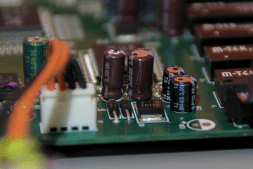In the previous article of this series, we looked at some of the major noise considerations in different power regulator topologies. Noise from these sources eventually makes its way to other components, and it could interfere with other portions of a system. Depending on the types of components used elsewhere in the system, noise may be innocuous or it may cause a design to … [Read more...]
EMC Design in Power Electronics Part 1: Regulators
INTRODUCTION Modern electronics demand low EMI and EMC conformance, both of which are related to component selection and physical layout in the power supply section of a device. Many more designs are demanding higher power levels alongside high power efficiency, as well as low-noise power supplied to mixed-signal systems. As a result, EMI and EMC challenges are more apparent … [Read more...]
When EMC is of Vital Importance
Santa Rosa, California, March 2023 – Electromagnetic compatibility (EMC) is a growing concern in medical technology and regulatory standards continue to implement measures to prevent disruption in wireless communication between medical applications, which can have severe consequences for the patient. SCHURTER works diligently to stay abreast of equipment trends and their … [Read more...]
SCHURTER’s Comprehensive Fuse Selection Guide Helps Engineers Find the Right Fuse!
Santa Rosa, California, February 28th, 2023 – Protecting circuits from overcurrent is essential to avoid equipment damage. Selecting the right fuse saves on costs of repairs and replacements, enhances equipment reliability and ultimately customer satisfaction; but selecting the right fuse can be challenging. The SCHURTER fuse portfolio offers a wide range of solutions for … [Read more...]
EMC Focus: Power Supplies
Electromagnetic Interference (EMI) is always a potential problem with switched-mode power supplies, both AC-DC and DC-DC converters. Modern designs can perform well for emissions and immunity but external connections must still be correct for the best performance. Sometimes, extra filtering is necessary to meet specific application requirements. However, incorrect filter … [Read more...]
EMI Filtering 101: Understanding the Basics
Introduction To start at the very beginning, what is an electrical filter? An electrical filter can be passive, active, analog, or digital. It is a device usually composed of discrete components which can be placed between circuits, networks, or equipment/systems to either emphasize, de-emphasize or control the frequency components of a desired or undesired signal. The term … [Read more...]
Good SI, PI and EMC require this most of all…
Good SI, PI and EMC require a proper, grown-up understanding of electricity... Instead of what circuit designers are taught! As electronic designers, we were taught the children’s version of electricity at school, college, university, etc. This is the version that pretends (just as the SPICE simulator does) that electricity flows as little packets of charge totally inside … [Read more...]
Plugging into a Power Source 93 Million Miles Away
Harwin Gecko-MT 1.25mm pitch Mixed Layout Connectors Connect with confidence with Harwin’s Gecko-MT range; the smallest and lightest mixed-layout connector available for high-reliability applications. The Gecko-MT range combines the 1.25mm pitch Gecko signal connector system with mixed technology layouts, which adds 10A power contacts to the range, providing additional … [Read more...]
An Isotropic Probe for Radiated Susceptibility Measurements from 10kHz to 18GHz and 5V/m to 220V/m
Abstract: Isotropic probes are available for radiated susceptibility test level measurements from 100kHz to 6GHz, 2MHz to 18GHz, 2MHz to 40GHz and 2MHz to 60GHz. For MIL-STD-461 and DO-160 testing a frequency range of 10kHz to 18GHz would be better and a possible solution is presented here. Introduction The probe described in this paper has three separate sections, … [Read more...]
Functional Safety, Risk Management, EMC and EMI
What is Functional Safety? The safety of products, systems and installations can be split into two parts: i) ‘Basic’ safety: electric shock, excessive temperatures, excessive radiation, fire, explosion, implosion, bruising, pinching, crushing, cutting, emissions of toxic fumes, etc. ii) ‘Functional’ safety: when things being controlled don’t function correctly … [Read more...]
- « Previous Page
- 1
- …
- 4
- 5
- 6
- 7
- 8
- …
- 40
- Next Page »















